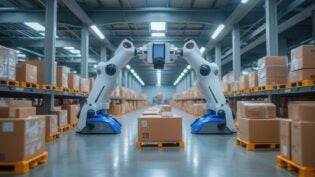10 Ways Small Retailers Can Build a Successful Supply Chain of the Future
By: Nitish Sharma

We are about to enter a new era of supply and demand but a number of global supply chains are not well equipped to face it. Although they are capable of handling high-volume, stable production at the present time, this may not suffice in the future. There awaits a perennial stream of worries for supply chains as a result of the impending complexity and uncertainty in global business.
About two-thirds of consumers take to online shopping at least once a week. However, only 19% of the top retailers can effectively manage the omni-channel demand. The biggest challenges faced by these retailers lie in transportation and logistics.
Hence, in order to thrive in this fast evolving business scenario, retailers must consider the following steps to derive more from the supply chains in the days to come.
With more and more consumers resorting to online shopping, retailers are under constant pressure to deliver a more effective service. To be able to do that, they must know the exact whereabouts of all things all the time.
1. Managing inventory
Retailers are always struggling to strike a balance between supply and the unpredictable consumer behavior. These two make it more difficult for retailers to bring together supply and demand. A cloud-based supply chain network or a returns management software like the Reverselogix platform will allow retailers to keep track of the inventory and changes in demands.
2. Employing RFID and source tagging to track stock levels
Retailers can use a source tagging program to better manage the supply chain right from the moment the product is deployed from the warehouse of the manufacturer. Source tagging will help take informed business decisions by creating awareness and providing information about the location and volume of merchandize available at all the channels. For example, it is possible to continuously keep a check on the warehouse stock levels and replenish it whenever the sensors perceive a near out of stock condition.
3. Use free shipping as an incentive
It has been found that free shipping of products purchased online has a major role to play in boosting e-commerce. Nearly 90% of consumers said that they would purchase again if products are shipped to them for free. However, many retailers have set timelines too long or the free shipping threshold way too high for the consumers to reach. Retailers should take into consideration the need to improve process in areas like order margins. Also, investing in technologies that support automated distribution options can help.
4. Integrate faster shipping into logistics
Retailers are constantly trying to upgrade their logistics model to integrate faster shipping options for their consumers. 70% of consumers opt for two-day shipping, a large number of whom have used Amazon services. There are also retailers who offer same-day delivery services. Partnering with on-demand delivery services can help retailers deliver goods to their consumers effectively and within a short time.
5. Organize a smooth online return
Consumers are more likely to prefer an online store that has a smooth return policy in place for its products. Of the many processes that have led consumers to abandon a brand, a difficult return policy of a purchased item is one. However, 58% of the consumers said they would be shopping online more if the processes were simpler. Hence, in order to attract more customers to online shopping retailers must make sure that they have the analytic databases and inventory required to provide free return.
6. Make habitual online shoppers shop more
It has been seen that those who shop more often than others can be persuaded to buy more by providing them with easier ordering and delivery options. These online shoppers who shop at least twice a week are likely to be persuaded more by one-day or two day shipping services.
7. Faster delivery by drones
As some of the major retailers are constantly attempting to outdo each other in terms of faster and more effective delivery services, the drone technology assumes precedence. It is soon going to become one of the most convenient and preferred modes of delivery in the future with 79% of the consumers likely to opt for drones for one-day deliveries and 73% willing to shell out more money for it.
8. Engage in B2B e-procurement networks
Companies can benefit in a number of ways by partaking in B2B e-procurement networks. They can foresee possible disruptions in the supply chain and take adequate measures. It is important for businesses to have a complete knowledge of their supply chains and not just their own suppliers.
9. Ensure co-operation between marketing and supply chain teams
In order to launch a promotion, retailers need to ensure that the marketing and the supply chains are in sync. If the supply chain team is made aware of an upcoming promotion beforehand they can prevent the shortage of products by pre determining how much product is required and how it will be shipped.
10. Splintering traditional supply chains
In order to meet the challenges related to optimizing supply chains companies can break their traditional monolithic supply chains into smaller ones. This will help them save money, handle complexity and serve the customers better.
By managing the supply chain better it is possible to bring a larger number of consumers into the online shopping community. Besides variety, low prices and good quality, it is also necessary to maintain an effective supply chain to meet the needs of the consumers more efficiently.
3013 Views












